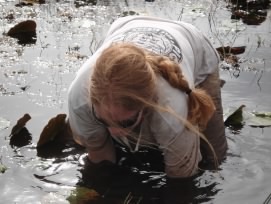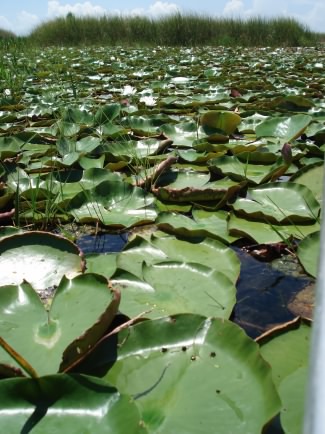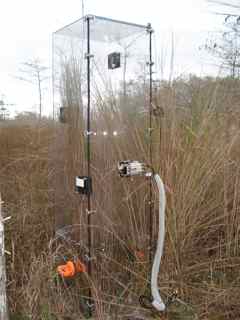Current Research Projects
Ridge-Slough Patterning; Status: Finished
While a great deal is known about the communities making up the ridge slough landscape, relatively little was known about the metrics of the landscape pattern. In this projects, we considered peat elevation differences between ridges and sloughs as indicators of state. Using peat elevation differences (based on water depth measurements), we were able to show ridges and sloughs as more than just communities; they are distinct ecosystems with unique and discrete characteristics. Further, alterations in soil elevation differences between ridges and sloughs are a leading indicator of landscape change with both drainage and impoundment.
Read all about the results in my thesis or in Ecosystems.
Ridge-Slough Nutrients
The transition zone between ridges and sloughs is narrow and steep, which suggests the existence of a mechanism allowing differential peat accretion rates at the edges of ridges. Multiple hypotheses for the maintenance of this step elevation gradient have been proposed. These include erosion/deposition processes and nutrient gradient differences allowing ridges to be more productive. These hypotheses allow us to make prediction of the soil characteristics. For example, if depostion on ridge edges (i.e, of neutrally buoyant calcite-rich periphyton from sloughs) is occuring, there should be a legacy signal of calcium content in the soils from the ridge edge inwards. If transport of soluble nutrients into the ridge edges is occuring (e.g., via transpiration gradients), then there should be a legacy signal of phosphorus in the soil and porewater.
This project measured soil and porewater nutrients across the ridge-slough edges in 4 locations in the central Everglades. Patterns of nutrient concentrations, calcium, and bulk density were compared with soil elevation (a determinative for community type).
Tree Island Nutrients
Tree islands exhibit a number of characteristics different from that of the surrounding landscape. The most obvious difference is their woody vegetation. Apart from that, they exist at a higher elevation and have phosphorus levels as much as 2 orders of magnitude higher than the surrounding marshes. This has been attributed to two main mechanisms
1. Inputs by bird guano and
2. Evapotranspirative pumps pulling nutrients towards the islands.
HHMI Undergraduate Fellow Jake Diamond lead a project to evaluate the contribution of nutrients by birds via 15N signatures in the peat soils.
Click here to learn more of this project from Jake Diamond.
Everglades NEE; Status: Ongoing
The ridge-slough of the Everglades provides and excellent model system for testing the hypothesis that the dominant ecosystems in a patterned peatland represent alternative configurations to achieve carbon equilibrium with the regional landscape. Further, the presene of a hydrologic gradient from modern hydrologic modifications of large portions of the Everglades allows for tests of deviations from this equilibrium. The existence of multipe peat accretion equilibria has been proposed but never explicitly tested in this landscape.
Successful restoration of the Everglades will require a quantification of the hydrologic conditions under which elevation differences and patterning between ridges and sloughs can be maintained. The recent (~100 years) drainage and impoundment of the ridge-slough landscape provides a living laboratory for the control hydrology has on carbon dynamics, with some areas much drier than historical conditions and others much wetter. Since restoration success is predicated on 'getting the hydrology right', the hydrologic gradient present in the Everglades provides both an opportunity for understanding alternative state stability in a subtropical wetland and a unique opportunity to study the drivers behind state stability loss. Enumerating the rates of carbon in and out of ecosystems as a function of local and regional hydrology is of intrinsic restoration value. The Comprehensive Everglades Restoration Plan has several performance measures related to the ridge-slough landscape, including the stability of the ridge-slough vegetative patterning, inundation patterns, with differing inundations of ridges and sloughs explicity considered, and sheetflow measures, including timing and distribution of flows and flow volume and continuity. All of these performance measures necessarily consider the maintenance of elevation differences between ridges and sloughs as a component of successful restoration.
The overall objective of this project is to investigate the carbon dynamics of the two dominant patch types in the ridge slough patterned landscape along a gradient of hydrologic modification. To achieve this objective, I plan to test whether the two states in the best conserved Everglades are in carbon equilibrium and investigate the degree to which net autotrophy has been lost iwth hydrologic modification. I will do this via investigations into how respiration and primary productivityrespond to hydrologic drivers, both in observation and my simulation models. The combined outcomes of these studies will be able to provide guidance about the hydrologic conditions necessarry for the maintenance of elevation differences between ridges and sloughs.
Projects
Images
-

- Ridge Slough Landscape

- Collecting Soil Cores

- Tree Island View

- Measuring Ecosystem Carbon